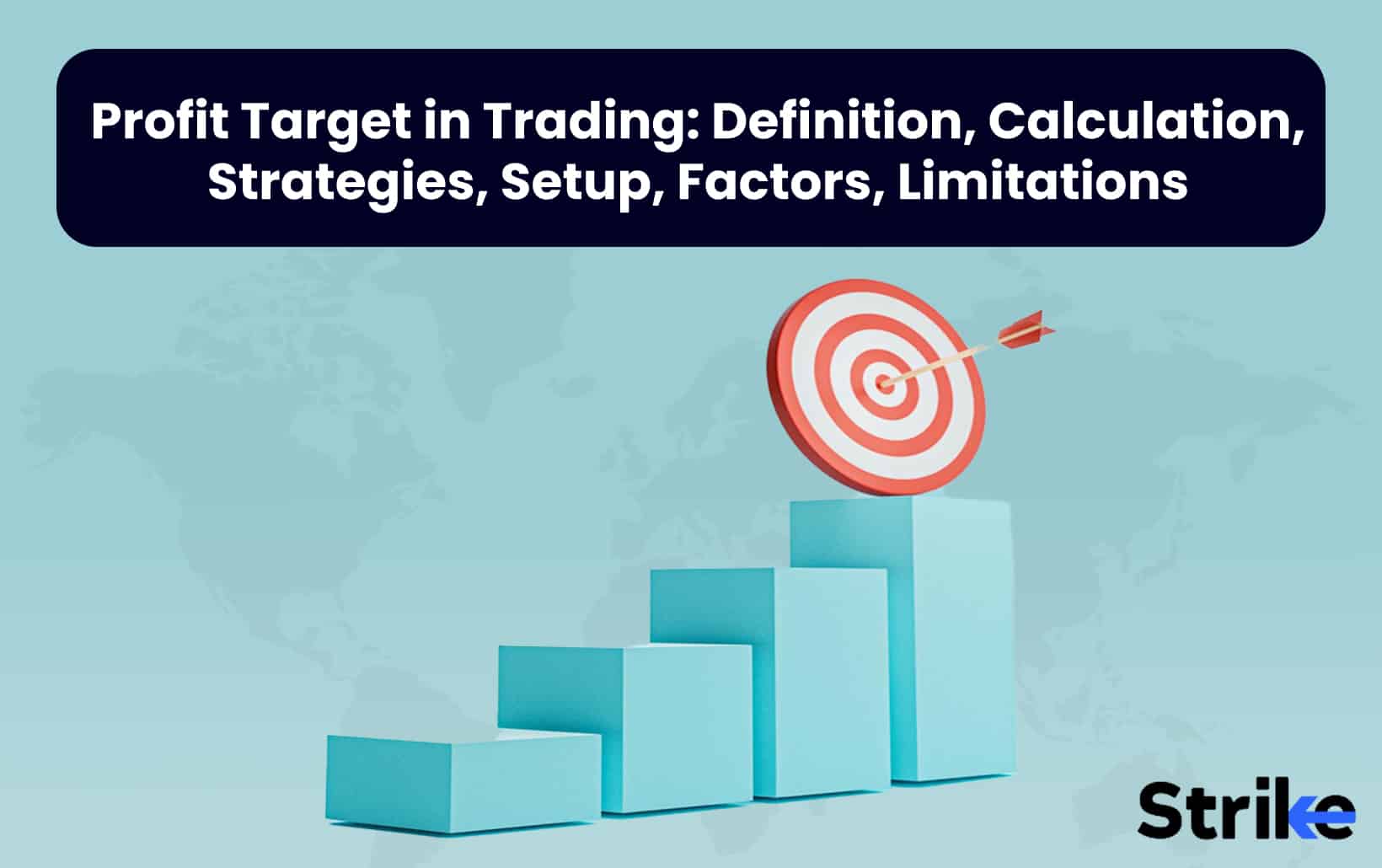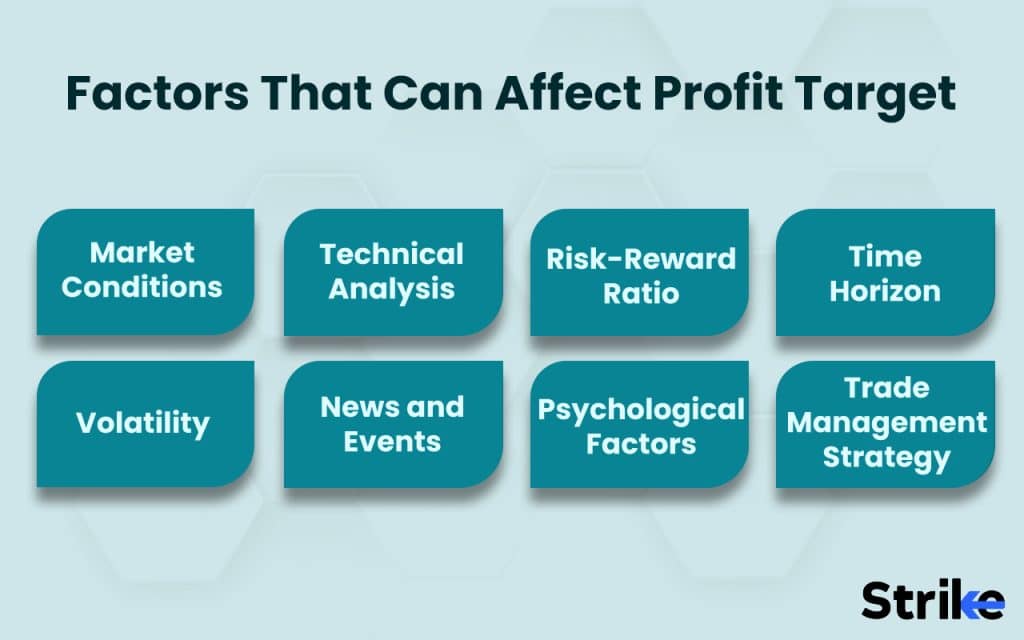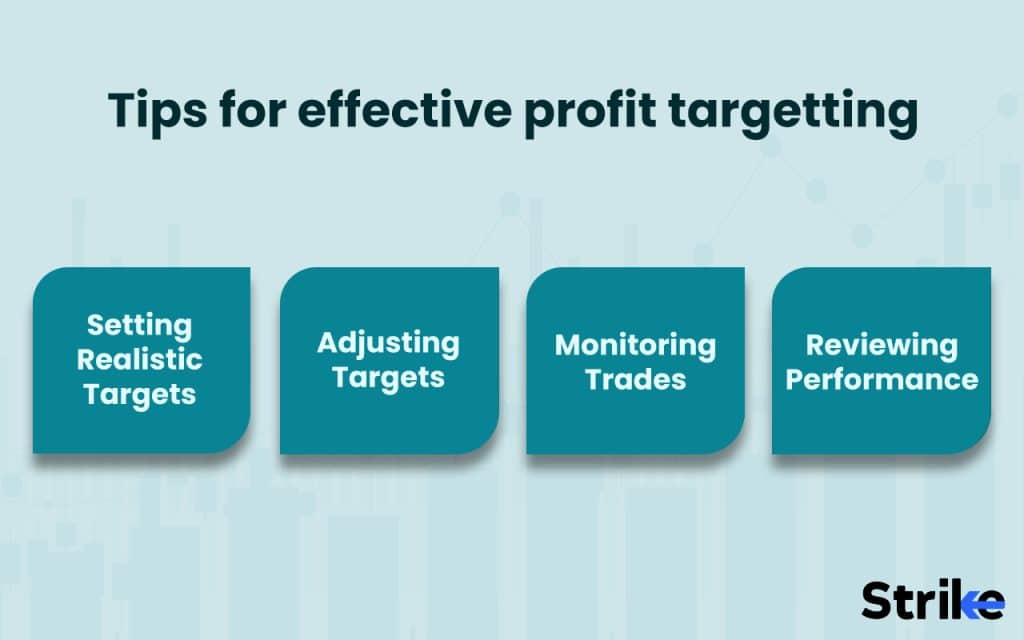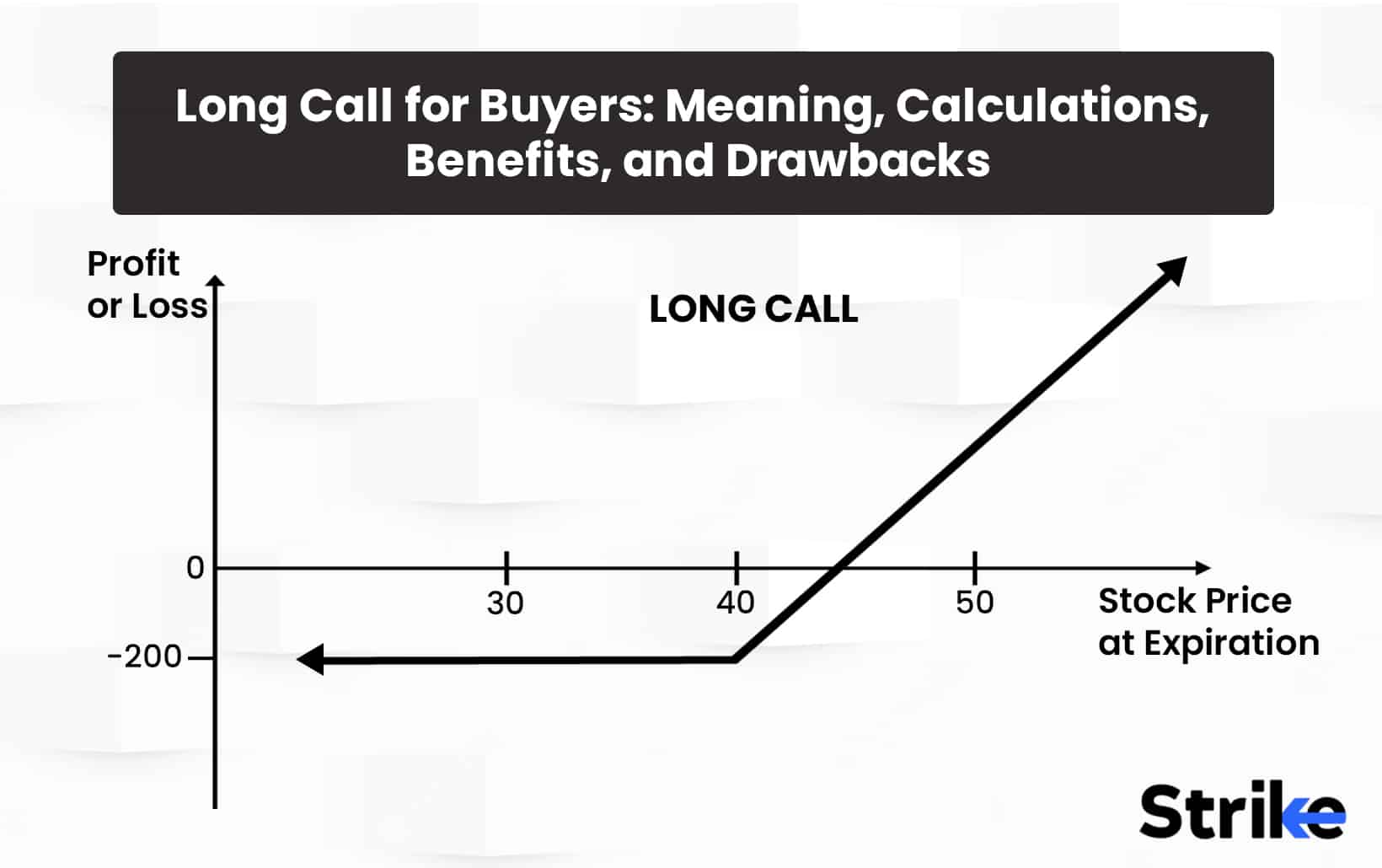
A profit target is a specific price level at which a trader will close out a position and take profits. It’s an objective part of a trading plan, allowing a trader to lock in gains and manage risk without undue emotions interfering as the trade unfolds. Profit targets are based on an existing support or resistance level identified using technical analysis, trend-following techniques, using indicators like Fibonacci retracements, or some other method designed to project the likely extent of a move in a particular market.
Once a trade has become profitable, a trader will typically place a stop order at the profit target price to close out the position and realize the gain. Profit targets are important because they allow for disciplined exits, helping traders avoid the perils of greed while sticking to the plan and booking the gains when the price objective is reached.
Why should you set a profit target while trading?
Profit targets are an established way of planning an exit strategy. Setting a profit target allows traders to plan ahead and take a logical and rational approach to exiting a trade. By knowing in advance where to take profits, traders remove emotion from the decision and have a predefined level at which to close their trade. A profit target is placed. The traders figure out the risk-reward ratio for a trade beforehand and stick to a plan; this will help avoid greed and trying to make even more on a winning trade, and at the same time, avoid holding a loser, hoping it will come back.
A profit target, from the onset, protects a trader from holding onto a position too long, unwinding a winning position before the market turns. Closing at a planned profit target is where players take money from a market, a time to be happy with the results and have a sense of achievement as part of the trading strategy. Profit targets promote disciplined exits, as traders exit when the target is reached rather than trying to squeeze out more gains. Quantifying possible upside for trade also helps assess if the potential reward merits the defined risk before entering.
How do you calculate the profit target?
The Google results give answers to how companies calculate profit targets. The writer has written below using his own knowledge. It sounds correct to me.
The profit target is calculated by first determining your risk level on a trade, which is the maximum amount you’re willing to lose if the trade goes against you. This is usually calculated as a percentage of your account size or as a fixed amount per trade. Once the risk level is set, you then determine your reward level, which is how much profit you want to target on the trade. A common risk-reward ratio is 1:2, meaning you aim to make twice as much profit as you’re risking on the trade.
Consequently, your profit objective would be Rs. 200 if your trading risk was Rs. 100. Take your entry price, add the difference between your entry and stop-loss levels, and then multiply that amount by the reward ratio to find the price goal. A 2:1 ratio multiplied by the Rs. 5 possible loss, for instance, indicates a profit objective of Rs. 10 at Rs. 60 if you purchase a stock for Rs. 50 with a stop loss of Rs. 45.
What are the strategies for profit targets?
The major profit target strategies used by traders include setting a fixed percentage target, using a trailing stop-loss that follows the price, basing targets on Fibonacci retracement levels, and setting a target based on a multiple of the stock’s average true range.
1.Fixed target
A fixed target is a trading strategy a trader implements where they essentially establish a price level at which they aspire to exit the trade. Having successfully entered a long position, the trader will aspire to sell the position once the price reaches the fixed target price, having chosen this level from their analysis of the chart in advance. The fixed target appears on the price in the form of a horizontal line. The trade is managed as the price approaches the level, and should it meet it, the deal is terminated. The trader then seeks a new trading opportunity and sets a new fixed target based on updated analysis. Fixed targets provide discipline to take profits at predefined points rather than relying on emotion in volatile markets.
3. Trailing target
Trailing target is an exit strategy that involves moving the target price upwards as the price of the asset rises. As profits accumulate, the stop loss and profit target levels trail behind the current market price at a set distance. This allows profits to run during sustained uptrends while having an adaptive strategy to close trades if the trend stalls or reverses. On a chart, the trailing target appears as a moving horizontal line below the market price for long trades. The stop loss preserves profits and leaves up the possibility of more gains in the event that the price retraces. The target will continue to rise as long as the uptrend is sustained. The transaction will end when the lagging objective is ultimately reached, albeit if momentum pauses. The goal is to let profits run in strong trends while having an adaptive exit strategy. Trailing targets allow traders to participate in the majority of a trend’s move while reducing the risk of giving back profits. This exit strategy works well for momentum-based trading strategies.
3. Fibonacci target
Fibonacci targets are price levels calculated using Fibonacci retracement levels to identify areas of potential support or resistance. The trader first identifies a significant swing between the high and low on the chart. Fibonacci retracement levels are then plotted at key ratios between these two points. Common ratios like 38.2%, 50%, and 61.8% are used to find potential support and resistance levels. During an uptrend, these become possible price targets where the asset sometimes stalls or reverses. On the chart, horizontal lines are drawn at the Fibonacci levels to mark the upside targets. A price break above a Fibonacci objective suggests that the trend will continue to gain strength. Traders will close a portion of the position at each target and trail stops to protect any remaining profits. Fibonacci targets provide theoretically-based exit levels to take profits near potential areas of reversal.
4. ATR based target
An ATR-based target uses the Average True Range indicator to set adaptive price targets. The ATR measures a stock’s volatility by calculating the average trading range over a period. A multiple of the ATR is added to the entry price to project an exit target. On the chart, the ATR level is plotted as a band around the price bars. As volatility increases, the ATR band widens, and the profit target moves further away from the entry price. The goal becomes closer to the entry price as the volatility decreases and the ATR band narrows. Active traders will adjust the ATR multiplier to match the stock’s volatility conditions. ATR-based targets create a dynamic exit strategy by linking the target to actual volatility rather than fixed levels. This adapts the target to changing market conditions to balance risk and reward.
The main idea behind setting targets is to have a risk management strategy to take profits near logical areas of support, resistance, or volatility. Targets help traders stick to a plan rather than rely on emotion during trades.
How do we set profit targets?
To set profit targets, we first determine a targeted return on invested capital based on your risk tolerance and investment goals. You must then calculate what target gross profit margin you will need to achieve this profit goal based on expected trading volume and other possible revenue sources. After you have prepared a 12-month forecast of your anticipated sales by month and by product category, you will be able to estimate how much you expect to earn from trading. You must also forecast such costs as commissions, data fees, and software expenses to arrive at an estimated projected cost of goods sold. Compare your forecasted gross profit margin with the target you’ll need to hit, and if necessary, change your trading activity.
Profit Target for day trading
To set profit targets for day trading, you first need to determine their risk tolerance and acceptable loss amount per trade. Then, you use technical analysis like support and resistance levels, chart patterns, and indicators to identify potential entry and exit points for trades. To minimize losses in the event that trade swings against them, traders should establish a stop loss before joining the transaction. A common rule of thumb is to risk no more than 1-2% of the total account size per trade.
For target profits in day trading, traders aim for a reward that is 2-3 times the amount risked for that trade. For instance, aim for a profit of Rs. 200–300 if you are investing Rs. 100 every trade. Day trading strategies include moving stop losses to break even once the trade becomes profitable; then, trailing stops to lock in gains as the target price nears. It’s important to stick to predetermined profit targets and not get greedy, hoping for larger gains. Consistently banking small profits adds up over time. Reviewing trade history helps fine-tune profit targets for different market conditions and asset classes in day trading.
Profit Target for swing trading
In the case of profit targets for swing trading, you first determine the amount of capital they are willing to risk per trade, often 1-5% of their account size. For instance, risking 2% on a 10,000 rupee account would entail risking 200 rupees every trade. Then, they use technical analysis to identify entry and exit points, setting a stop loss to contain potential losses if the trade moves against them. Using the example Rs. 200 risk, a stop loss could be placed Rs. 200 below the entry price.
For profit targets, swing traders often aim for gains that are 2-3 times the amount risked, or Rs. 400-600 in the example. This means a Rs. 200 potential loss is covered by a Rs. 600 potential gain. Traders sometimes trail stops to lock in partial profits as the target price nears. The key is giving trades room to fluctuate while still having an advantageous risk-reward ratio. Swing trading profits compound over time, so traders should remain disciplined, stick to plans, and let winners run. Reviewing trade history helps refine profit targets for changing market environments. Setting intelligent profit targets relative to risk allows swing traders to remain profitable even if not every trade is a winner.
Profit target for long-term investing
To set profit targets for long-term investing, you first need to determine the time horizon and goals for the investment. For example, investing for retirement in 20 years or saving for a house down payment in 10 years. Then, research the average historical returns of the stock market, often 8-10% annually. Consider the fundamentals of potential investments, choosing companies with competitive advantages, strong leadership, and growth potential. Enter positions at attractive valuations or dollar-cost averages over time. Manage risk by diversifying across sectors, market caps, and asset classes.
Set profit targets based on the initial investment thesis and adjust periodically as company and market conditions evolve. Targets are sometimes revised upward if the investment thesis is playing out better than expected. Review holdings every so often and trim positions if valuations become excessive. Be patient in pursuit of long-term growth rather than reacting to short-term volatility. Let winners run to maximize compounding. Establish intelligent profit targets aligned to investment time horizons and regularly re-evaluate.
What factors can affect profit targets?
Let us see six factors that affect profit targets.

Market Conditions: Play a role in how lofty you set your targets. In a bull market, you may consider aiming higher. During a bear market, keeping it modest may be a more appropriate course of action.
Technical Analysis: Traders will often use chart patterns and technical indicators to identify support and resistance in the form of price point(s). As a starting point, these metrics may help you set your initial profit targets.
Risk-Reward Ratio: The potential profit you might make relative to the money you could end up losing on the trade. If your risk-reward ratio is high, it may suggest you could afford to set relatively high-profit targets.
Time Horizon: It’s also worth considering the time frame of your trade when setting your targets. For example, it might be more appropriate to have smaller goals if you’re day trading versus swing and/or position trading, where those might be larger.
Volatility: High volatility means big price swings and potentially the ability to hit your targets with ease. Low-volatility markets may require you to be more conservative in your targets.
News and Events: Major news, earnings, data releases, etc., all have an impact on your targets as they tend to change the market environment.
Psychological Factors: These factors could have a strong influence on your target setting. Trader psychology and trader personality might lead to some traders being more conservative and, as a result, setting smaller targets.
Your trade management approach is the key here. It also has an effect on your targets. Using tighter trailing stops and/or having rules about when to take profits could result in smaller targets.
What common mistakes happen while setting up a profit target?
Setting targets that are too low, not adjusting targets in changing conditions, using rigid targets without flexibility, and not monitoring active trades closely are all common shortcomings when setting up profit targets. Traders will often take profit levels too close to the entry price; they are quick to lock in a quick gain but then fail to let their profits run. They’ll also forget to increase their take profit level as a trade becomes more profitable. Traders should adjust their profit targets, especially when a stock is trending strongly. Using predetermined fixed-take profit levels without regard for different market conditions means missed opportunities. Traders also sometimes miss opportunities to lock in profits when targets are hit because they fail to watch open trades.
What are the limitations of the profit target?
Profit target limitations include overlooking the time value of money, discounting risk factors and mixing short-term thinking with long-term sustainability. They frequently focus on making a certain dollar amount in a specific time frame, ignoring the reality that cash flows received in the future have less value than those received today and that returns are compared only when they occur over the same time periods.
They ignore the risk-free rate — the best that is earned without any risk of capital loss — and fail to account for other risks that affect results. This leads to taking excessive risks, or leveraging up, to hit a profit target, overtrading, emotional decision-making and excessive use of capital on a single trade. The drive to hit short-term profit goals often comes at the expense of long-term strategic thinking, sustainable growth and shareholder value creation. Companies that are hyper-focused on profit targets instead of return on capital sometimes underinvest in research and development, human capital, and environmental or social responsibilities.
Is it necessary to use stop loss along with profit target?
Yes. Placing a stop-loss order is an important risk management tool that helps traders limit losses on a position. While profit targets define the upside profit goal, using stop losses keeps unforeseen events or volatility from causing catastrophic loss. Thus, using stop losses in combination with profit targets is a balanced approach that allows for pursuing gains while also defining the maximum acceptable risk. Skilful traders will adjust stop losses as trades move favourably to lock in gains.
While stop losses do not guarantee execution at the stop price, they are an essential part of any disciplined trading. They require traders to acknowledge the maximum loss they are willing to accept, which in turn supports prudent position sizing. Combining profit targets and stop losses demonstrates the thoughtful planning and risk mitigation that is necessary for successful stock market trading.
What is partial profit booking?
Partial profit booking is the process of selling some quantity of shares of your investment to earn partial profits and keep the remaining shares in your portfolio if the stock moves further. It involves booking gains on a portion of your holdings while continuing to hold the rest. Investors use this strategy to lock in some gains as the stock price rises while maintaining exposure in case it continues to move higher. The goal is to balance profit-taking with remaining invested.
In the event that your 1,000 shares have appreciated 20%, for instance, you could dispose of 300 of them to realize some gains while hanging onto the remaining 700 shares to perhaps increase your winnings should the upswing continue. Partial profit booking helps manage risk by securing some profits while allowing you to participate in further upside. It lets investors gradually exit a position through partial sales over time rather than closing the entire position at once. It aims to balance taking profits and maximizing returns.
Tips for effective profit targeting
Targeting profits effectively takes planning, adjusting, review, and discipline. Set realistic profit targets based on historical trends and volatility. Conservative targets allow flexibility as the market shifts.

Adjust profit targets as new information emerges. As price action unfolds, update targets to align with developing trends. Stay nimble. Monitor trades closely and take profits at target levels. Resist greed when targets are reached. Follow the plan. Review performance regularly. Analyze why targets were hit or missed. Refine strategy based on lessons learned. Experience brings wisdom.








![85 Common Stock Market Terminologies for Dummies [Updated List for 2025] 28 85 Common Stock Market Terminologies for Dummies [Updated List for 2025]](https://www.strike.money/wp-content/uploads/2025/04/Popular-Stock-Market-Terms-for-Beginners-Banner.png)











No Comments Yet.